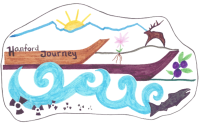Hanford Journey 2022
FOR IMMEDIATE RELEASE
Yakama Nation and 200 People Gather along the Columbia River to Advocate for Hanford Nuclear Site Cleanup

Mattawa, WA (June 24, 2022)—Today, 200 people gathered along the Columbia River’s scenic Hanford Reach for The Hanford Journey, a day-long event to take a collective stand for Hanford cleanup, despite the U.S. Department of Energy’s waning commitment to a real cleanup. Speakers, including Yakama Nation Government Relations Liaison, Davis Washines, and Director of the Washington Department of Ecology, Laura Watson, called on the United States government to ensure Hanford cleanup protects all people that rely on the Columbia River.
Photo slide show from the event, images by Sky Bear Media:
People from across the Pacific Northwest, including Yakama Nation elected officials, tribal government staff, and citizens, experienced the stunning beauty of Columbia's Hanford Reach. Attendees heard from several experts, viewed shuttered nuclear reactors from jet boats, and learned about cultural resources and traditional ecological knowledge. Some took a guided hike along the White Bluffs, and others heard from the Puyallup Canoe Family about generations of tradition on the water. The second annual Hanford Journey was co-sponsored by Yakama Nation Environmental Restoration and Waste Management (ERWM) Program and non-profit Columbia Riverkeeper.
Speakers during this portion of the event included: Elaine Harvey, Traditional Food Gatherer and Yakama Nation Tribal Member; Laura Watson, Director of the Washington Department of Ecology; Davis Washines, Government Relations Liaison, Yakama Nation.
In her remarks before the event, Laura Watson, Director of the Washington Department of Ecology, said, “The Hanford Site is and remains one of the most contaminated sites in the world, and is probably the most complicated cleanup that’s ever been undertaken in human history... We know that it’s not just a Department of Ecology fight, it’s a fight that we’re pleased to take alongside tribes, local and regional organizations. The federal government has made a commitment to all of us, but especially to tribes. Yakama Nation pushes us at times, and we welcome that. They push us hard, and it makes us better regulators. Hanford is a statewide priority and it needs to be a nationwide priority. Failure is simply not an option.”
Davis Washines, Government Relations Liaison, Yakama Nation, said, “We come here today to recognize the work on what you call ‘Hanford Nuclear Reservation. There’s a history here to this area and people. This is an important place we have a duty and a responsibility to protect because all the children here represent the future. The elders are told, ‘We don’t own this, it doesn’t belong to us—it belongs to them, even the ones not even born yet.’ We have a responsibility to teach them, their generation will have the ability to carry on. Especially our oral traditions that explain our way of life.”
The 586-square-mile Hanford Site is a legacy of World War II and the Cold War. For over 40 years, the federal government and its contractors generated unprecedented volumes of hazardous and radioactive waste. Today, the U.S. Department of Energy is responsible for one of the largest nuclear cleanup efforts in the world.
This year’s Hanford Journey was an incredible event sharing the past, present, and future of Hanford clean up,” said Dan Serres, Conservation Director, Columbia Riverkeeper. “We need to hold the federal government accountable: Radioactive and toxic pollution from the Hanford Nuclear Site threatens people’s health, salmon, and water quality. I hope people walk away feeling inspired to continue the fight.
The Hanford Journey coincides with a series of recent developments at Hanford that have called into question the U.S. Department of Energy’s (Energy), the federal agency responsible for Hanford cleanup, commitment to a real cleanup of Hanford that is protective of human health and the environment. For example, Energy's insistence on reclassifying high-level nuclear waste, which poses a major threat to groundwater and the Columbia River.
About Yakama Nation Environmental Restoration & Waste Management (ERWM) Program
The Yakama Nation uses its authorities under the Comprehensive Environmental Recovery and Compensation Liability Act (CERCLA) and the Washington State Dangerous Waste regulations (WAC 173-303) to participate in the process of cleanup and restoration of hazardous waste sites on the Hanford Site. The Yakama Nation Environmental Restoration and Waste Management (ERWM) Program is tasked with the oversight of this process and issues affecting Hanford Site natural resources. ERWM’s involvement in these sites includes participation in technical, project management, and policy meetings on response and natural resource damage actions. In addition, ERWM has cultural staff that provides oversight of cultural resource compliance, as well as monitors, identifies, and cares for the cultural resources and traditional cultural properties located on the Hanford site.
About Columbia Riverkeeper
Columbia Riverkeeper’s mission is to protect and restore the water quality of the Columbia River and all life connected to it, from the headwaters to the Pacific Ocean. Representing over 16,000 members and supporters, Columbia Riverkeeper works to restore a Columbia River where people can safely eat the fish they catch and where children can swim without fear of toxic exposure. Columbia Riverkeeper is a member of Waterkeeper Alliance, the world’s fastest-growing environmental movement, uniting more than 300 Waterkeeper organizations worldwide. For more information, go to columbiariverkeeper.org.
Resources:
Hanford is the most contaminated site in the Western Hemisphere. Cleanup matters.
Join Columbia Riverkeeper to hold the U.S. government responsible for cleaning up the most contaminated site in the Western Hemisphere: the Hanford Nuclear Site.


